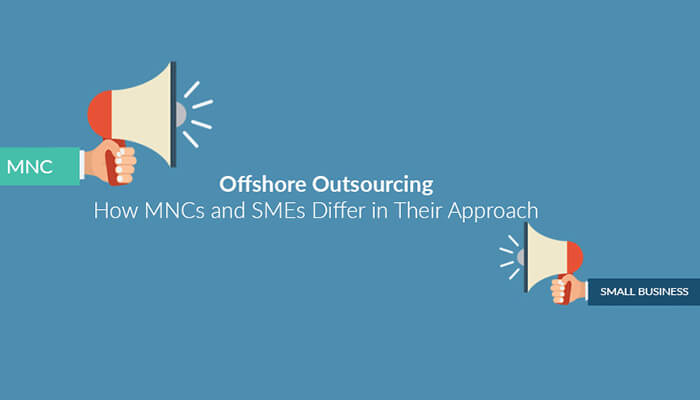In the previous two parts of this series of articles we defined outsourcing, offshoring and offshore outsourcing and also the advantages unique to each of these business functions. In this part we look at the key differences between how SME/ SMBs and MNCs outsource, offshore and offshore outsource and the history behind that with a special emphasis on India as a outsourcing destination.
At the very outset let us understand that MNCs outsource, offshore and offshore outsource while SMEs mostly just outsource. Offshore outsourcing is a relatively new function to their kitty of business functions. The latter being a relatively new phenomenon. Let us look at the history of outsourcing
The History of Outsourcing of MNCs in India
In 1983, Data Basics Corporation, an American company, got in touch with Infosys, a then small Indian company to outsource its software development. This planted the seeds of outsourcing in India. In the 1990s some global airlines began outsourcing their back office work to India. Soon, companies were quick to realize the cost advantage and competitive edge to multinationals. Cost restructuring, improvement in quality, time to focus on core business and innovations, speed to market, increased revenue led multinationals to switch to outsourcing and offshore outsourcing as part of their global corporate strategy. Texas Instruments, American Express, SwissAir , British Airways and GE soon started captive units in India.
Historically MNCs have taken advantage of all three business functions –outsource, offshore and offshore outsource but SMEs have been confined to just outsourcing until recently. The reasons are not far to fathom. MNCs on the basis of their superior cash flow were easily able to override the prerequisites required to start and maintain operations related to starting and maintaining captive units in the mother country or overseas. The irony couldn’t have been more obvious. In order to save money, you had to first invest a significant sum of money. This was a luxury a SMB could ill-afford. So, till the 1990s, SMBs had to make do with only outsourcing and outsourcing reached them in the form of Freelancing.
SMEs and Outsourcing
SME outsourcing is a more recent trend that predominantly started with project outsourcing because SMEs of course couldn’t set up their own branch offices offshore. So, the best way for them to retain some sort of control was by hiring freelancers. In the 90s it was still difficult for a SME to get hold of freelancers but all that changed with the advent of the internet. Elance which started in 1999 was and remains the oldest freelance job portal. Today numerous online freelance job portals like freelancer, o –desk, fiverr, guru and others provide a lively and thriving market for freelancers and SMEs. However, in the long run SMEs realized that freelancers were not the perfect solution for multiple reasons like lack of dedication to one single organization and turnaround time of work. Freelancers were fine for short-term work but what if your project needed long-term attention?
In such a scenario in the early years of the 21st century came the concept of Virtual Employees or simply VEs which gave SMEs the happy medium of having their own dedicated staff and resources without spending on overhead costs. So for example you could be a SME working in the domain of app development in US and have a dedicated development team working for you out of India, complete with their own in-house infrastructure that you needn’t invest a penny on.
In the early stages of outsourcing, cost and headcount reduction were the most common reasons to outsource. They still remain some of the top reasons to outsource but today there is more at stake than just cost and headcount reductions. Today, the drivers are more strategic such as seeking how companies can best utilize their core competencies and not spend much time on non-core processes. This is what VEs have allowed SMEs to do.
Thus in the 21st century offshore outsourcing is no longer a pipedream for SMEs thanks to VEs and it wouldn’t be an exaggeration to say that VEs have put SMEs on par with multinational giants when it comes to outsourcing and offshore outsourcing at a fraction of the cost spent by MNCs.








